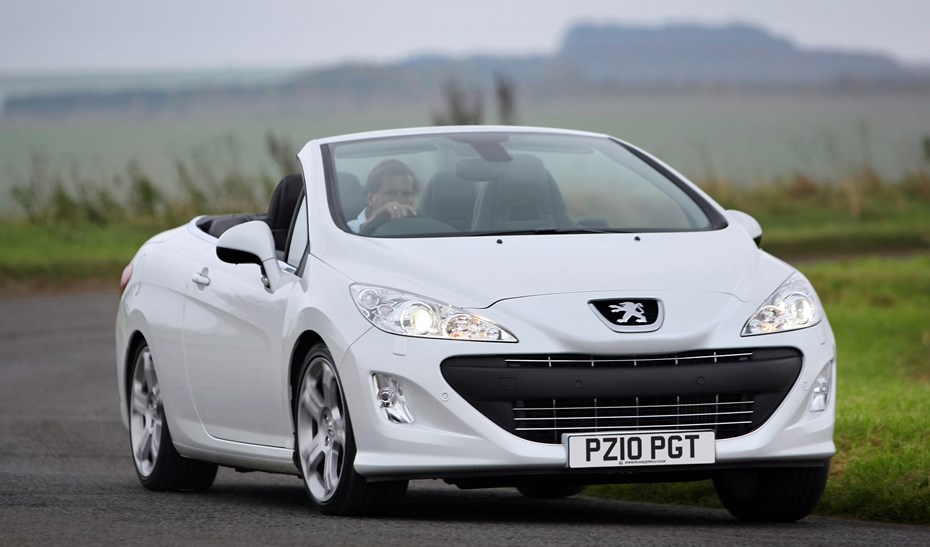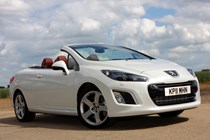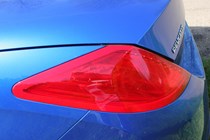
Peugeot 308 CC engines, drive and performance

There’s a decent choice of both petrol and diesel engines in the 308 CC range. The cheapest model is powered by a 1.6-litre VTi unit with 120bhp. This was developed with BMW and is the same engine that’s used in the MINI Cooper. It’s adequate rather than exciting – as proven by its 0-62mph time of 13.2 seconds – and is let down by a slack five-speed manual gearbox.
There are two more powerful 1.6-litre petrols which use turbochargers and are labelled THP – the 150bhp version is available with a manual only and the 140bhp version comes exclusively with an automatic gearbox. The 150bhp THP engine is a real gem and feels urgent and zesty from low down, plus it comes with a positive-shifting six-speed gearbox, so you can make the most of the relatively modest 150bhp.
The 140bhp is poor though. While the engine has a similar nature, any performance is hampered by the woeful four-speed automatic which is hopelessly dated, especially when other manufacturers offer six or even seven-speed double clutch automatics. Peugeot responded to this in January 2010 with the launch of a six-speed automatic linked to a 156bhp version of the 1.6 THP petrol engine.
In terms of diesels, the entry level engine is a 1.6-litre HDi with 110bhp and a 0-62mph time of 13.1 seconds. It’s refined and has decent pulling power. The other choice is a 2.0-litre HDi available with 140bhp and a 0-62mph time of 11.1 seconds. This is also available with a six-speed automatic gearbox (power drops to 136bhp as a result) although economy drops from 48mpg to 40mpg.
If you’re not bothered by performance you could do well with the new e-HDi version. It’s not quick with acceleration to 60mph taking 12.2 seconds but you’ll be happy that visits fuel stations are few and far between.
The biggest criticism of the 308 CC is the lifeless steering which lacks feel. It’s acceptable when cruising, but on more demanding road it’s too light and doesn’t inspire much confidence. Worse still, it transmits bumps through the steering column, especially when cornering, which makes smooth driving difficult. The ride is poor too and whether the roof is up or down it fidgets and struggles to smooth out potholes.
It’s far better suited to motorway cruising.



.jpg)
.jpg)
.jpg)
.jpg)
.jpg)
.jpg)
.jpg)
.jpg)
.jpg)
.jpg)
.jpg)
b.jpg)

.jpg)
.jpg)
.jpg)
.jpg)
.jpg)
.jpg)
.jpg)
.jpg)
.jpg)

.jpg)
.jpg)
.jpg)
.jpg)
.jpg)
.jpg)
.jpg)
.jpg)
.jpg)
.jpg)
.jpg)
.jpg)
.jpg)
.jpg)
.jpg)
.jpg)
.jpg)
.jpg)
.jpg)
.jpg)
.jpg)
.jpg)
.jpg)
.jpg)
.jpg)
.jpg)
.jpg)

.jpg?quality=50)
.jpg?quality=50)
.jpg?quality=50)
.jpg?quality=50)
.jpg?quality=50)
.jpg?quality=50)
.jpg?quality=50)
.jpg?quality=50)
.jpg?quality=50)
.jpg?quality=50)
.jpg?quality=50)
b.jpg?quality=50)

.jpg?quality=50)
.jpg?quality=50)
.jpg?quality=50)
.jpg?quality=50)
.jpg?quality=50)
.jpg?quality=50)
.jpg?quality=50)
.jpg?quality=50)
.jpg?quality=50)

.jpg?quality=50)
.jpg?quality=50)
.jpg?quality=50)
.jpg?quality=50)
.jpg?quality=50)
.jpg?quality=50)
.jpg?quality=50)
.jpg?quality=50)
.jpg?quality=50)
.jpg?quality=50)
.jpg?quality=50)
.jpg?quality=50)
.jpg?quality=50)
.jpg?quality=50)
.jpg?quality=50)
.jpg?quality=50)
.jpg?quality=50)
.jpg?quality=50)
.jpg?quality=50)
.jpg?quality=50)
.jpg?quality=50)
.jpg?quality=50)
.jpg?quality=50)
.jpg?quality=50)
.jpg?quality=50)
.jpg?quality=50)
.jpg?quality=50)